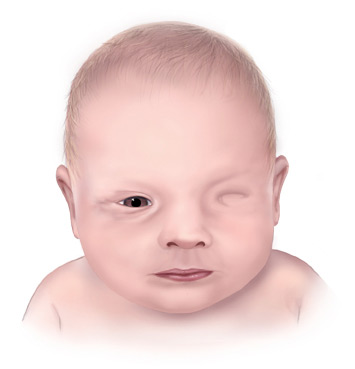Share This Article
If you’ve just found out that your child has anophthalmia or microphthalmia then you will no doubt want to know more about the eye condition. It relates to children born without one eye (anophthalmia) or with very small eyes (microphthalmia). It is often detected before birth, in prenatal tests through a physical examination. Treatment involves medication, surgery and/or prosthetic eyes. Both of these eye conditions are rare, but they can cause some vision loss or even complete loss of sight.
Treatment for Anophthalmia
There is no treatment to restore vision loss caused by anophthalmia but if dealt with early enough, there are certain treatments available that can still help babies and children cope with the condition. Often, people with the condition have smaller than average eye sockets which can alter their face shape. The condition can also lead to other conditions, especially with microphthalmia such as cataracts (which results in a cloudy eye lens), coloboma (which is when normal tissue in the eye or surrounding the eye is not present) or microcornea, which is when the outer layer of the front of the eye is small with an unusual curve. These other conditions can cause health problems and usually, children with these conditions experience other birth defects.
The Causes of Anophthalmia
The causes of this eye condition are still unknown, but it is believed that gene mutations are one cause. This occurs during pregnancy before birth and often there are other birth defects that happen as well. Medication during pregnancy can also lead to anophthalmia. That is why taking medicine such as Accutane and isotretinoin are dangerous as is thalidomide. Another cause is when a foetus comes into contact with harmful substances or environment, such as X-rays, drugs, chemicals, pesticides, radiation, or viruses.
Reducing the Risk of Anophthalmia and Microphthalmia
To avoid anophthalmia and microphthalmia, it’s best to talk to your doctor about what you can do to reduce the risk during pregnancy. It’s always wise to have a thorough health check-up before you decide to get pregnant and to discuss any medication you are on too. You could also visit a genetic counsellor to gain a deeper understanding of your genes and any risk attached to gene mutations. During pregnancy, visiting your health practitioner or doctor regularly to ensure your pregnancy is healthy is essential. Always avoid harmful environments, pesticides, and chemicals during pregnancy and if you take supplements, discuss these with your doctor to check their safety.


Diagnosing Anophthalmia and Microphthalmia
The condition can be picked up during routine pregnancy examinations or post-birth. During pregnancy, your doctor or gynaecologist can check for both conditions using certain tests such as ultrasound (which is a safe imaging that examines the foetus), a CT scan (a safe x-ray) or through genetic testing which is a blood test that examines tissues and blood to detect genetic disorders.
Treating Anophthalmia and Microphthalmia
You cannot restore lost vision unfortunately but there are other treatments that can help babies and children with these conditions, such as special devices called conformers. These help the eye socket grow and develop. Prosthetic eyes are also a treatment, they help to normalise the eyes’ appearance and assist with eye socket development. Find out more about prosthetic eyes for anophthalmia here: https://ocularpro.com/ocular-prosthesis-for-congenital-anophthalmia-and-microphthalmia/.
Glasses and Goggles
There are also protective eyewear glasses or goggles which protect the eye from further injury. Some children with vision despite the condition can wear an eye patch on their stronger eye. This helps to strengthen the weaker eye’s vision by forcing the brain to send visual signals to it, rather than to the stronger eye therefore strengthening and improving vision. Additionally, some children may need surgery to enlarge the eye socket or to fit a device. Some children with these conditions also develop the eye condition cataracts which will require surgery.
If you’ve been told your baby or child has one of these conditions, then early intervention is essential to prevent further visual impairment. Speak to your doctor and eye specialist to determine a suitable care plan. The best eye doctors will be ophthalmologists, orbital and oculoplastic surgeons and ocularists – the latter make and fit prosthetic eyes. Your child may also need therapy at a later date to help with their development.
